|
| |
|
SoC Conference Presenters'
Bios & Abstracts
15h International System-on-Chip
(SoC)
Conference, Exhibit & Workshops
The Theme for This
Year’s Conference Is “Secure and Intelligence Silicon Systems for
Emerging Applications."
|
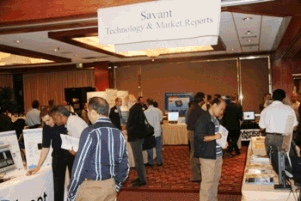 |
|
To present and/or exhibit at this
highly-targeted International System-on-Chip (SoC) Conference, please contact:
949-981-1837 or SoC.Conf.Update@Gmail.com
|
|
|
Click Here To
Download The UCI Campus Map
Directions &
Parking for Calit2 Building at the University of California, Irvine (UCI)
Platinum Sponsors
Click Here To
Download The UCI Campus Map
Directions &
Parking for Calit2 Building at the University of California, Irvine (UCI)
|
|
|
|
|
|
|
|
Day
One Wednesday October 18, 2017
SoC Conference Program Agenda* |
|
|
|
Savant
Company Inc.
 |
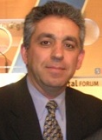 Farhad
Mafie, SoC Conference Chairman. Farhad
Mafie, SoC Conference Chairman.
Welcome and Opening Remarks, Technology/Market Trends.
Farhad Mafie is SoC Conference
Chairman. He has over
20 years of experience in semiconductor and computer businesses and more
than 10 years of university-level teaching experience. He is the former Vice
President of Marketing and Engineering at Toshiba Semiconductor. He has also
worked in strategic marketing, project and design engineering at Lucent
Technologies, Unisys, and MSI Data. Farhad has a Master of Science and a
Bachelor of Science degree in Electronic Engineering from California State
University, Fullerton. He is an author and a translator, and his articles
have been published in a variety of journals and Web-based magazines on
technology and political affairs. In 2003, he published the biography of
Iranian poet and Nobel nominee who lived in exile, Nader Naderpour
(1929-2000), Iranian Poet, Thinker, Patriot. Farhad is also Editor-in-Chief
for the CRC Press SoC Design and Technologies Book Series, which includes
(1) Low-Power NoC for High-Performance SoC Design and (2) Design of
Cost-Efficient Interconnect Processing Units. Farhad is an active member of
IEEE, and he is the chair of IEEE Orange County Solid-State Circuits Society
(SSCS), as well as IEEE Orange County Entrepreneurs' Network (OCEN). He is
also a member of two UCI Advisory Committees: Communication System
Engineering and Embedded System Engineering Certificate Programs.
|
|
|
|
UC Irvine

 |
 Dr.
Michael J. Klopfer, Technical Director, CalPlug - California Plug Load
Research Center, California Institute for Telecommunications and Information
Technology (Calit2), University of California, Irvine. Dr.
Michael J. Klopfer, Technical Director, CalPlug - California Plug Load
Research Center, California Institute for Telecommunications and Information
Technology (Calit2), University of California, Irvine.
“University Collaboration
for Electronics Education."
Abstract: For electronics
component and solutions manufacturers, interfacing the educational
environment can be a challenge. In this presentation, we will share
experiences from within the university based on working with undergraduate
and graduate students as well as professional researchers to help understand
the barriers to effective uptake of demonstration and education focused
products.
Bio:
Michael is doctoral graduate in biomedical engineering. He has a background
in consumer electronics and power systems, and has designed and constructed
high-load power supplies and power management systems for x-ray generators.
He has also led numerous projects related to the planning and installation
of power, data and low voltage interface lines and assisted in the
installation and upgrade of factory automation systems.
|
|
|
|
EPIC semiconductors

|
 Wolf
Richter is the company's president, EPIC semiconductors. Wolf
Richter is the company's president, EPIC semiconductors.
“Alma-Mater-on-Chip: nanoCloudProcessors (nCPs) reverse Moore's law.”
Abstract: TThere is no question that the microprocessor has changed the
world. But approaching its limits, it has become increasingly difficult to
enhance its performance further. The reason: it’s increasingly challenging
to overcome "Moore's Law". Doubling transistor functions, and reducing the
chip price with no successor in sight, until now!
A nanoCloudProcessor (nCP) is literally a dust-sized device. It has been
designed well over a decade and its not bounded by "Moore's law”. It was
created to overcome the major challenges facing today's semiconductors:
Cost, Power, Complexity, Microwave, Distraction and Inherent Artificial
Intelligence. A single nanoCloudProcessors is 40um/side. 200,000 of them can
be combined as an array with the size /price of a modern 50-cent
micro-controller, allowing 20 billion operations per second at 100KHz. Wolf
will demonstrate some features of an nCP live on stage.
Bio: Wolf Richter is the company's president for EPIC semiconductors. Both
entrepreneur and inventor, he is devoted to pioneering communication
technologies and services. He has more than three decades of technology
development experience and has an outstanding track record of economical
innovations. Wolf has authored more than 150 patents and won awards at Expo
2000 - Austria Microsystems 2005 and Echelon 2007. His innovations has also
led to the German Economy Award for Best Innovation and an Ernst & Young
entrepreneurship award in 2007.
|
|
|
|
Synopsys
 |
 Manmeet
Walia, Senior Product Manager for Mixed-Signal PHY IP, Synopsys. Manmeet
Walia, Senior Product Manager for Mixed-Signal PHY IP, Synopsys.
“25G Interconnect Solution for New Wave of Computing/Networking SoCs.”
Abstract: The tremendous amount of bandwidth increase is the byproduct of
the new wave of high-performance computing/networking applications including
big data analytics, machine learning, network functions virtualization (NFV),
wireless 4G/5G, in-memory database processing, video analytics & network
processing. The performance of SoCs for these applications must maintain
their robustness as the voltage and temperature conditions vary in harsh
data center environments. For this reason, designers are leveraging high
speed, high-performance, low latency and low-power multi-protocol interface
IP solutions to access interconnects that complement higher CPU processing
power, and provide the necessary capabilities for power, performance, and
area tradeoffs. Designers also turn to configurable RTL to implement a
growing percentage of their design ensuring their product is optimized for
its targeted application. In this presentation, we will highlight
semiconductor and IP market trends in next-generation SoCs for emerging
computing/networking applications. We will also describe the advantages of
leveraging high-speed interface IP that supports various high-speed
industry-standard interconnect protocols like PCI Express, Ethernet and CCIX.
Bio: Manmeet Walia is a Senior Product Manager for Mixed-Signal PHY IP at
Synopsys. He brings more than 15 years of experience in product marketing,
product management and system engineering covering ASSP, ASIC, and IP
products for broad range of applications. Manmeet holds a Master of Science
degree in Electrical Engineering from University of Toledo, and an MBA from
San Diego State University.
|
|
|
|
Morning Break |
Morning Break |
|
|
|
Microsemi

|
 Dr.
Rino Micheloni is Engineering Fellow at Microsemi Corporation. Dr.
Rino Micheloni is Engineering Fellow at Microsemi Corporation.
“Flash Controllers for SSD’s Lifetime Extension through Machine Learning.”
Abstract: The advent of 3D Flash memories introduced significant
issues in terms of characterization and system-level optimization that can
be performed to increase memory’s reliability over time. In this work we
show how machine learning algorithms can help designers to improve 3D
reliability. Experimental results based on TLC 3D NAND devices will be used
to demonstrate the effectiveness of machine learning in the context of Flash
memories.
Bio: Dr. Rino Micheloni is Engineering Fellow at Microsemi Corporation where
he currently runs the Non-Volatile Memory Lab in Milan, with special focus
on NAND Flash. Prior to joining Microsemi, he was Fellow at PMC-Sierra,
working on NAND Flash characterization, LDPC, and NAND Signal Processing as
part of the team developing Flash controllers for PCIe SSDs. Before that, he
was with IDT (Integrated Device Technology) as Lead Flash Technologist,
driving the architecture and design of the BCH engine in the world’s 1st
PCIe NVMe SSD controller. Early in his career, he led NAND design teams at
STMicroelectronics, Hynix, Infineon, and Qimonda; during this time, he
developed the industry’s first MLC NOR device with embedded ECC technology
and the industry’s first MLC NAND with embedded BCH. Rino is IEEE Senior
Member, he has co-authored more than 50 publications, and he holds 242
patents worldwide (including 120 US patents). He received the
STMicroelectronics Exceptional Patent Award in 2003 and 2004, and the
Qimonda IP Award in 2007.
Rino has published the following books with Springer: 3D Flash Memories
(2016), Inside Solid State Drives (2013), Inside NAND Flash Memories (2010),
Error Correction Codes for Non-Volatile Memories (2008), Memories in
Wireless Systems (2008), and VLSI-Design of Non-Volatile Memories (2005).
|
|
|
|
Intel
Keynote
 |
 Cormac
Brick, Director of Machine Intelligence, Movidius Group, Intel Corporation. Cormac
Brick, Director of Machine Intelligence, Movidius Group, Intel Corporation.
Keynote: “Designing
for Deep Learning Inference in Power Constrained Environments.”
Abstract: TBD.
Bio: Cormac Brick is Director
of Machine Intelligence in the Movidius group at Intel Corporation, where he
builds new foundational algorithms for computer vision and machine
intelligence to enhance the Myriad VPU product family. Cormac contributes to
internal architecture, and helps customers build products using very latest
techniques in deep learning and embedded vision through a set of advanced
applications and libraries. Cormac has worked with Movidius since its early
days and has contributed heavily towards the design of the ISA, hardware
systems design, computer vision software development and tools. Cormac has a
B.Eng. in Electronic Engineering from University College Cork.
|
|
|
|
Lunch |
Lunch |
|
|
|
Microsemi
Keynote

|
 Ted
Speers, VP and Head of Product Architecture and Planning for Microsemi SoC
Group. Ted
Speers, VP and Head of Product Architecture and Planning for Microsemi SoC
Group.
Keynote:
“RISC-V Challenges and Possibilities.”
Abstract: TBA
Bio: Ted Speers is Head of
Product Architecture and Planning for Microsemi’s SoC Group, responsible for
defining their roadmap for low power, secure, reliable FPGAs and SoC FPGAs.
He joined Microsemi in 1987 and held roles in process engineering and
product engineering before assuming his current role in 2003. He is a
Technical Fellow and co-inventor on 35 US Patents. Prior to joining
Microsemi, he worked at LSI Logic. Ted has a BS in Chemical Engineering from
Cornell. |
|
|
|
SiFive
 |
 Jack
Kang, VP of Product and Business Development, SiFive Jack
Kang, VP of Product and Business Development, SiFive
“Introducing the New RISC-V U54 Coreplex.”
Abstract: In this presentation, SiFive, a founding member of the RISC-V
Foundation, will introduce the U54 Coreplex, a multi-core 64-bit
application-processor-class RISC-V CPU. The new design supports a quad-core
configuration featuring a coherent L2 cache, support for the latest RISC-V
specifications (including RV64GC, machine, supervisor, and user privilege
modes), and external debug support. The new CPU supports Linux, Unix,
FreeBSD, and other advanced operating systems in the RISC-V ecosystem.
Bio: Jack is currently Vice President of Product and Business Development at
SiFive. Prior to SiFive, Jack held a variety of senior business development,
product management, and product marketing roles at both NVIDIA and Marvell,
with a long track record of very successful, large scale design wins. Jack
started his career as a frontend design engineer, with a focus on CPU
architecture and design. Jack received his BS degree in Electrical
Engineering and Computer Science from UC Berkeley.
|
|
|
|
Imperas Software Ltd.
 |
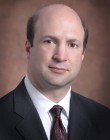 Larry
Lapides, VP, Imperas Software Ltd. Larry
Lapides, VP, Imperas Software Ltd.
“RISC-V Models and Simulation Enable Early Software Bring Up.”
Abstract: As RISC-V processor cores start to be designed into new SoCs,
software requirements need to be considered. One of the issues with moving
to RISC-V based SoCs is porting operating systems, drivers, firmware and
applications from existing platforms. Can this be easily accomplished? Can
it be accomplished, in the majority, before silicon is available? Virtual
platforms, or software simulation, can help accelerate this porting and
bring up process. Virtual platforms provide a near real time software
simulation environment for executing the actual software binaries, plus have
full debug, analysis and test tools. Now there are not only models of
RISC-V processor cores – generic RISC-V, SiFive, Andes; 32 and 64 bit cores
– but also models of platforms running operating systems. These Extendable
Platform Kits (EPKs) enable software engineers to quickly get started,
months before any hardware, even FPGA prototypes, are available. For
example, there is an EPK available of a Microsemi platform, using a SiFive
E31 RV32-based core, running FreeRTOS. Virtual platform environments also
enable the use of debug, analysis and test tools, not only for RISC-V, but
in the case of a heterogeneous platform, supporting the multiple processors
on the platform. Also, as Agile methods, including Continuous Integration
Continuous Test (CICT) are adopted by embedded software teams, virtual
platforms with their ease of automation enable this technology to be
implemented. This presentation will provide a summary of the RISC-V
processor models available through the Open Virtual Platforms (OVP) website
(www.OVPworld.org), show a demo of the Imperas Microsemi E31/FreeRTOS EPK,
and discuss the use of virtual platforms in accelerating migration to RISC-V
based SoCs and improving software quality.
Bio: Larry currently runs worldwide sales and marketing at Imperas Software
Ltd., and previously ran worldwide sales at EDA companies Averant and
Calypto Design Systems. He was vice president of worldwide sales during the
run-up to Verisity’s IPO (the top performing IPO of 2001), and afterwards as
Verisity solidified its position as the fifth largest EDA company. Before
Verisity and SureFire Verification (acquired by Verisity), Larry held
positions in sales and marketing for Exemplar Logic and Mentor Graphics.
Larry was recently an Entrepreneur-in-Residence at Clark University’s
Graduate School of Management, where he developed and taught a course on
Entrepreneurial Communication and Influence. Larry holds a BA in Physics
from the University of California Berkeley, a MS in Applied and Engineering
Physics from Cornell University and a MBA from Clark University. Outside of
high tech, Larry enjoys food and wine, and contributes to his wife’s website
for wine region travel, ViciVino.com.
|
|
|
|
Codasip
 |
 Dan
Ganousis, Director of NA Business Development, Codasip. Dan
Ganousis, Director of NA Business Development, Codasip.
"A High-Level Design Methodology for RISC-V Processor Development."
Abstract: High-level design methodologies have shown very promising results
by producing better quality of results (QoR) as compared to RTL designs.
However, high-level design methodologies have been very slow to be adopted
by ASIC and SoC design teams because of their long learning curve and the
significant expertise required to realize better QoR. Codasip realized
that high-level design methodologies were especially suited for targeted
applications such as DSP, embedded processors, silicon security, and
accelerators. This presentation will describe how Codasip has successfully
implemented a high-level design methodology based on their CodAL language,
Codasip Studio tool suite, and UVM verification flow to develop and verify
their IoT and security RISC-V embedded processors. Results will be
shown from actual ASIC design projects comparing embedded processors
developed in an RTL flow with manual creation of their software design kits
(SDK) versus embedded processors created using Codasip’s high-level design
flow. A RISC-V based processor designed by SecureRF that has been optimized
to run IoT security applications will be described. The SecureRF RISC-V
processor is based on Codasip’s Bk core with extensions and optimizations to
allow single cycle processing of key aspects of SecureRF’s security
algorithms, without requiring changes to the existing software
infrastructure. Results from a recent Microsemi audio processor design will
also be shown where optimizing at the architectural level by adding DSP
extensions to the RISC-V ISA improved performance by over 56x compared to
their previous design that used an ARM embedded processor that could not be
modified or optimized.
Bio: Dan Ganousis has over 40 years of experience in the EDA and
semiconductor IP industry. He began his career working on processors at
Zilog (Z80), NCR (65c02), Digital (MicroVax) and Solbourne Computer (Sparc
KAP). Dan previously served as CEO of AccelChip and Arithmatica, and was on
the executive staff of Oasys Design, Cyclos, Innoveda, VeriBest, Viewlogic,
and Mentor Graphics. Dan currently oversees North American business
development at Codasip where he manages marketing, sales, and field
application engineering.
|
|
|
|
Dover Microsystems.
 |
 Steven
Milburn, Chief Technical Officer, Dover Microsystems. Steven
Milburn, Chief Technical Officer, Dover Microsystems.
“The Dover PIPE: Processor Interlocks for Policy Enforcement.”
Abstract: Preventable cyber security breaches are affecting governments,
businesses, and individuals around the world every day. These breaches
exploit errors in software stacks to gain access and control of devices.
Cyber security today is centered around software solutions that have proven
ineffective at preventing cyber attacks. Software consistently includes an
average of 15 defects per thousand lines of code [1]. These defects provide
open windows for hackers, and even the defensive cyber security software
itself is inherently vulnerable. Dover has a different solution, a hybrid
hardware-software solution, which can stop cyber attacks with hardware that
understands and enforces software defined security policies. Dover’s
IP solution, PIPE (Processor Interlocks for Policy Enforcement), is the
result of over 7 years and $31MM in government funding, starting with $25MM
worth of DARPA CRASH SAFE program funding to create inherently secure
processors that would be immune to the next Stuxnet [2]. Proof that the core
architectural principles could be grafted onto a conventional processor
extended with tags was presented at ASPLOS 2014 [3]. Draper Labs then
continued the work to commercialize the results of the SAFE project,
creating the first PIPE design and incubating Dover Microsystems until
spinning Dover out as an independent company in July 2017. PIPE is
designed around a concept of metadata tagging, wherein every piece of code
and data in the system has a corresponding metadata tag. These metadata tags
are inspected upon every instruction retired by the processor to ensure they
conform to all the policies installed on the SOC. These policies, and the
meaning of the metadata, are defined in a software suite that runs in a
secured fashion, either on an entirely separate core, or as a special
execution mode of the host processor. Instructions are checked against these
polices before any retired values are committed to the SOC. Therefore, PIPE
can stop a violation, and hence an attack, before executing even a single
instruction of the attack. Dover’s PIPE is designed to be an add-on block to
any RISC-V processor core. It captures an instruction trace and all writes
from the host processor, then checks each instruction against policies
before committing writes to the system. This decoupled designed enables host
processor to continue executing instructions in earnest when the PIPE
experiences a delay in evaluating policies for an instruction, and enable
the PIPE to catch up to the host processor by taking advantage of the
pipeline bubbles in the host processor resulting from multi-cycle
instructions, branches, or cache misses. The decoupled architecture also
enables the PIPE design to have flexible mapping of data to metadata tags.
It is possible to utilize fewer and/or smaller tags for various areas of
memory, and to place tags into a protected addresses space not accessible by
the host processor. To facilitate this decoupled elastic interface between
the PIPE and host processor, a new interface definition is proposed for
inclusion in RISC-V implementations that wish to connect to the PIPE. This
new interface definition will enable a wide range of IP connections beyond
Dover’s PIPE unit. Examples include the Debug Support Unit from the River
CPU project, and tandem verification IP to compare Spike instruction traces
to that of hardware.
References
[1]Writing Solid Code, Steve Maguire
[2] For more publications and talks from the CRASH SAFE project, see http://www.crash-safe.org/papers.html
[3] U. Dhawan, C. Hritcu, R. Rubin, N. Vasilakis, S. Chiricescu, J. M.
Smith, T. F. Knight Jr, B. C. Pierce, and A. DeHon, “Architectural support
for software-defined metadata processing,” ACM SIGARCH Computer Architecture
News, vol. 43, no. 1, pp. 487–502, 2015.
Bio: Since joining the team in May 2016, Steven has led Dover’s design
effort to build a secure microprocessor. As Chief Technical Officer, Steve
draws on his experience as a System-on-Chip and microprocessor architect, as
well as his program management and design leadership expertise, to drive
innovation and shape Dover’s technical direction. Steve has been lead
designer at two prior tech startups, both times bringing disruptive design
to market success with first-pass silicon. As an SOC Architect at Microchip
Technology, he was responsible for MIPS-based wireless microprocessor module
designs, founded the Program Management group, and led the PIC32 design
teams. Steve earned his BS in Computer and Electrical Engineering from the
University of Rhode Island.
|
|
|
|
IHS Markit Technology

|
 Robbie
Galoso, Principal Analyst, Industrial Semiconductors, IHS Markit Technology. Robbie
Galoso, Principal Analyst, Industrial Semiconductors, IHS Markit Technology.
"Industrial Semiconductors Market."
Abstract: The industrial semiconductors market was worth $43.4 billion in
2016 or 12.3% of the entire semiconductor market. Industrial electronics
spans a variety of application fields comprising manufacturing and process
automation, test and measurement, medical electronics, building and home
control, power & energy and military and civil aerospace. Industrial
electronics is a large fragmented market with more than 100 semiconductor
suppliers and around 50 of these companies earned more than $100 million
from this segment in 2016. It is an exciting market since it typically
provides higher margins than other semiconductor applications and the mid-
to long-term demand for industrial electronics is expected to be robust:
Factory automation will need more intelligence, as well as buildings to
reduce their energy consumption and emissions. The medical electronics
market will continue in its goal to benefit an increasingly ageing
population. Finally, growing demand in emerging countries for building
infrastructure, industrial transportation and avionics will also drive the
growth. Key Issues that will be addressed: What are the fastest growing
segments. What are the key trends and regulations driving the market. Who
are the suppliers and buyers of semiconductors for industrial electronics.
What is the impact of the emerging BRIC countries growing demand. What are
the opportunities for fast growing markets e.g. Digital Signage, smart
thermostats, smart meters, LED lamps and digital video surveillance.
Bio: Robbie Galoso, Principal Analyst. Robbie specializes in market research
with years of experience in primary and secondary research projects
involving companies in the electronics industry. At IHS, Robbie manages the
overall data quality of its semiconductor market share databases. Robbie’s
research reports provide insights shaping the products and companies in the
industrial electronics market which includes factory automation, security,
energy, medical, military & aerospace segments. His responsibilities also
include synthesis of worldwide economic trends to help generate accurate
market forecasts. Robbie earned his Bachelor of Business Administration in
International Business and Economics from Loyola Marymount University and
MBA from Peter Drucker School of Management at Claremont Graduate
University.
|
|
|
|
Afternoon Break |
Afternoon Break |
|
|
|
Panel






|
Panel:
“Specialized
Processors vs. General Purpose Cores: How to Achieve Performance
Requirements for Emerging Applications (including AI, Deep Learning,
Security, and Machine Intelligence).”
Moderator: Farhad Mafie, SoC Conference Chairman.
Panelists:
1. Cormac
Brick, Director of Machine Intelligence in the Movidius Group, Intel
Corporation.
2. Dr. Rino Micheloni is Engineering Fellow at Microsemi Corporation.
3. Jauher Zaidi, Chairman & Chief Innovation Officer, Palmchip Corporation.
4. Ted
Speers, VP and Head of Product Architecture and Planning for Microsemi SoC
Group.
5. Professor Eugenio
Culurciello, Associate Professor, Electrical Engineering. Purdue University.
6. Abdullah Raouf, Sr. Product Marketing Manager, Lattice Semiconductor.
This
Panel Is Open To Everyone . . .
Register Online for FREE Panel Pass
More
Updates Coming Soon . . .
Several
Opportunities to Win various Prizes During this Panel Discussion . . .
Don't
Miss Out!
|
|
|
|
Microsemi

|
 Dr.
Rino Micheloni, Engineering Fellow at Microsemi Corporation. Dr.
Rino Micheloni, Engineering Fellow at Microsemi Corporation.
Panelist
Bio: Dr. Rino Micheloni is Engineering Fellow at Microsemi Corporation where
he currently runs the Non-Volatile Memory Lab in Milan, with special focus
on NAND Flash. Prior to joining Microsemi, he was Fellow at PMC-Sierra,
working on NAND Flash characterization, LDPC, and NAND Signal Processing as
part of the team developing Flash controllers for PCIe SSDs. Before that, he
was with IDT (Integrated Device Technology) as Lead Flash Technologist,
driving the architecture and design of the BCH engine in the world’s 1st
PCIe NVMe SSD controller. Early in his career, he led NAND design teams at
STMicroelectronics, Hynix, Infineon, and Qimonda; during this time, he
developed the industry’s first MLC NOR device with embedded ECC technology
and the industry’s first MLC NAND with embedded BCH. Rino is IEEE Senior
Member, he has co-authored more than 50 publications, and he holds 242
patents worldwide (including 120 US patents). He received the
STMicroelectronics Exceptional Patent Award in 2003 and 2004, and the
Qimonda IP Award in 2007.
Rino has published the following books with Springer: 3D Flash Memories
(2016), Inside Solid State Drives (2013), Inside NAND Flash Memories (2010),
Error Correction Codes for Non-Volatile Memories (2008), Memories in
Wireless Systems (2008), and VLSI-Design of Non-Volatile Memories (2005).
|
|
|
|
Intel
 |
 Cormac
Brick, Director of Machine Intelligence, Movidius Group, Intel Corporation. Cormac
Brick, Director of Machine Intelligence, Movidius Group, Intel Corporation.
Panelist
Bio: Cormac Brick is Director
of Machine Intelligence in the Movidius group at Intel Corporation, where he
builds new foundational algorithms for computer vision and machine
intelligence to enhance the Myriad VPU product family. Cormac contributes to
internal architecture, and helps customers build products using very latest
techniques in deep learning and embedded vision through a set of advanced
applications and libraries. Cormac has worked with Movidius since its early
days and has contributed heavily towards the design of the ISA, hardware
systems design, computer vision software development and tools. Cormac has a
B.Eng. in Electronic Engineering from University College Cork.
|
|
|
|
Microsemi

|
 Ted
Speers, VP and Head of Product Architecture and Planning for Microsemi SoC
Group. Ted
Speers, VP and Head of Product Architecture and Planning for Microsemi SoC
Group.
Panelist
Bio:Ted Speers is Head of
Product Architecture and Planning for Microsemi’s SoC Group, responsible for
defining their roadmap for low power, secure, reliable FPGAs and SoC FPGAs.
He joined Microsemi in 1987 and held roles in process engineering and
product engineering before assuming his current role in 2003. He is a
Technical Fellow and co-inventor on 35 US Patents. Prior to joining
Microsemi, he worked at LSI Logic. Ted has a BS in Chemical Engineering from
Cornell. |
|
|
|
Purdue University
 |
 Dr.
Eugenio Culurciello, Associate Professor, Electrical Engineering. Purdue
University. Dr.
Eugenio Culurciello, Associate Professor, Electrical Engineering. Purdue
University.
Panelist
Bio: Eugenio Culurciello
(S'97-M'99) received the Ph.D. degree in Electrical and Computer Engineering
in 2004 from the Johns Hopkins University, Baltimore, MD. He is an associate
professor of the School of Electrical and Computer Engineering, the Weldon
School of Biomedical Engineering, the School of Mechanical Engineering, and
of Psychological Sciences in the College of Health & Human Sciences at
Purdue University, where he directs the ‘e-Lab’ laboratory. His research
focus is in artificial vision systems, deep learning, hardware acceleration
of vision algorithms. His research interests include: analog and mixed-mode
integrated circuits for biomedical instrumentation, synthetic vision,
bio-inspired sensory systems and networks, biological sensors,
silicon-on-insulator design. Eugenio Culurciello is the recipient of The
Presidential Early Career Award for Scientists and Engineers (PECASE), the
Distinguished Lecturer of the IEEE (CASS), and is the author of the book
"Silicon-on-Sapphire Circuits and Systems, Sensor and Biosensor interfaces"
published by McGraw Hill in 2009, and "Biomedical Circuits and System,
Integrated Instrumentation" published by Lulu in 2013. Info: https://engineering.purdue.edu/elab/
In 2013 Dr. Culurciello founded TeraDeep http://teradeep.com/, a company
focused on the design of deep neural network processors. In 2016 Dr.
Culurciello founded FWDNXT http://fwdnxt.com/, to deliver the next
generation synthetic brains for artificial intelligence.
|
|
|
|
Lattice Semiconductor

|
 Abdullah
Raouf, Sr. Product Marketing Manager, Lattice Semiconductor. Abdullah
Raouf, Sr. Product Marketing Manager, Lattice Semiconductor.
Panelist
Bio: Abdullah Raouf is a
senior product marketing manager for Lattice Semiconductor focused on FPGA
and ASSP solutions for mobile markets. He has more than a decade of
experience in semiconductor product management and holds a Bachelor of
Science degree in Electrical Engineering from UC Davis and an MBA from Santa
Clara University. |
|
|
|
Palmchip
 |
 Jauher
Zaidi, Chairman & Chief Innovation Officer, Palmchip Corporation. Jauher
Zaidi, Chairman & Chief Innovation Officer, Palmchip Corporation.
Panelist.
Bio: Jauher expert in
Cyber Security, Storage and SoC design. He has over 33 years of experience
in executive management and entrepreneurship. He helped start several
hi-tech companies name a few, Palmchip, ESilicon, SandForce, Netvinci, and
Moobila. He has written and presented a number of articles and papers on
Cyber Security, SoC, IP business model, and future business and technology
trends. He has also participated in many system-on-chip panels, and is a
recognized expert in the area of SoC development. He invented the CoreFrame
SoC memory centric Architecture. Which has enabled over 2 billion SoCs. He
is a board of Adviser for Savant Company, a leader in International
System-on-Chip conferences. He holds several patents on Cyber Security, SoC
technology and infrastructure. The EE Times, a well-known industry
publication, named him twice among the 'Top 20 visionary CEOs’ in the world.
He is recipient of 2010 Terman Technology award for his Cloud computing
innovation. He was 1st place award out of 34 cloud Applications.
Specialties: Startup, Entrepreneurship, Management, Financing, SoC
Technology and Chip design, Sales and Marketing, Fund raising, Startups. IT
outsourcing, Cloud Computing, Mobile (IPhone, Android) applications.
|
|
|
|
Networking |
Tabletop Exhibit and
Networking
|
|
|
|
|
Day TWO Thursday, October 19, 2017
SoC Conference Program Agenda* |
|
|
|
Savant
Company Inc.
 |
 Farhad
Mafie, SoC Conference Chairman. Farhad
Mafie, SoC Conference Chairman.
Welcome and Opening Remarks, Technology/Market Trends.
Farhad Mafie is SoC Conference
Chairman. He has over
20 years of experience in semiconductor and computer businesses and more
than 10 years of university-level teaching experience. He is the former Vice
President of Marketing and Engineering at Toshiba Semiconductor. He has also
worked in strategic marketing, project and design engineering at Lucent
Technologies, Unisys, and MSI Data. Farhad has a Master of Science and a
Bachelor of Science degree in Electronic Engineering from California State
University, Fullerton. He is an author and a translator, and his articles
have been published in a variety of journals and Web-based magazines on
technology and political affairs. In 2003, he published the biography of
Iranian poet and Nobel nominee who lived in exile, Nader Naderpour
(1929-2000), Iranian Poet, Thinker, Patriot. Farhad is also Editor-in-Chief
for the CRC Press SoC Design and Technologies Book Series, which includes
(1) Low-Power NoC for High-Performance SoC Design and (2) Design of
Cost-Efficient Interconnect Processing Units. Farhad is an active member of
IEEE, and he is the chair of IEEE Orange County Solid-State Circuits Society
(SSCS), as well as IEEE Orange County Entrepreneurs' Network (OCEN). He is
also a member of two UCI Advisory Committees: Communication System
Engineering and Embedded System Engineering Certificate Programs.
|
|
|
|
Infineon Technologies AG.
 |
 Pankaj
Singh, Ranga Kadambi, Kiran Kumar Bandlamudi, Martin Ruhwandl, Infineon
Technologies AG. Pankaj
Singh, Ranga Kadambi, Kiran Kumar Bandlamudi, Martin Ruhwandl, Infineon
Technologies AG.
“Effective Qualitative Fault Injection Methodology to support failure mode
analysis for ISO 26262 Automotive SoC.”
Abstract: Fault injection simulation during pre-silicon verification shall
confirm the effectiveness of the safety mechanisms to detect and control the
relevant failure modes in the monitored safety function logic. A qualitative
verification (i.e. confirmation of successful failure mode coverage by the
safety mechanism) is required to ensure that the safety architecture
considers all the potential failure modes. A more extensive statistical
fault injection simulation campaign may be necessary, to determine the
diagnostic coverage of the safety mechanism. Fault injection
simulation is performed using a design representation which accurately
models the behavior and internal working of the relevant functional failure
modes and safety mechanism (e.g. RTL code for digital logic). Faults may be
injected into the safety function logic in several ways:
• Test pattern with erroneous input pattern or input values
• Manipulation of internal states and signals via dedicated fault injection
modes and interfaces
• Manipulation of internal states and signals via the simulation environment
(e.g. Fault Injection)
• Manipulation electrical parameters to force an erroneous behavior of the
safety function
ISO26262 recommends fault injection as a verification technique to verify
the safety mechanisms at various levels of the development flow including
the verification analysis for the permanent, transient and multipoint
faults. However the standard does not provide guidance on the details of
implementation and execution.
In this presentation we share the Qualitative Fault Injection methodology to
verify, confirm the detection and control of all relevant failure modes in
the monitored safety function, existing limitations / pitfalls with
methodology and the outlook. A common platform based approach is used to
minimize the overall effort in extracting the fault sites and efficient
traceability of the failure modes to the actual evidence and results.
Bio/s:
Pankaj completed his Bachelors in Electronics from NIT Bhopal in 1993;
Master's in Electrical Engineering from USF, Florida and an MBA from SMU,
Dallas. He has 20 years of industry experience which includes various
leadership management roles. Currently he is leading Infineon’s Automotive
SoC verification division in Singapore. He has published 28 technical papers
in various international conferences.
Ranga Kadambi is currently working as Principal, Functional Safety
verification in the Automotive, Microcontroller division of Infineon. Vast
experience of greater than 19 years in semiconductor industry focusing on
the RTL design, Verification and expertise in Automotive functional safety
related verification aspects of the microcontroller development. Key
interests include the definition of holistic methodologies to ensure the
product is safe from systematic and random hardware faults.
Kirankumar has done his Masters in device physics from IIT Madras, India and
Master of Science in IC design from Nanyang Technological University,
Singapore. Broad experience of 16 years that covers product engineering,
Test engineering, Design for Test and verification. Key interests includes
fault
Martin Ruhwandl studied in electronic design and information technologies at
the Technical University in Munich where he also did his PhD. After joining
Infineon Technologies AG (Communication) in 1998 he moved to Lantiq (Wireline
Communication), and went back to Infineon (Automotive) in 2013. He is
working for close to 15 years in digital functional verification methodology
and implementation, meanwhile as Principal engineer. Besides bottom up and
system verification his main areas are of work is the random based, metric
driven verification. For high quality verification with strong focus on
reuse he developed and rolled out methodologies using ‘e’ as HDL on lower
level and C/SystemC on higher level within Infineon teams. With this
background he is now working on automotive IPs and SoC platforms where these
methodologies have to be further improved and automated to hit the required
safety standards (e.g. ISO 26262). The verification methodologies have been
presented in several international conferences.
|
|
|
|
TSI Semiconductors.

|
 Wilbur
Catabay, SVP TDCS & Corporate Strategy, TSI Semiconductors. Wilbur
Catabay, SVP TDCS & Corporate Strategy, TSI Semiconductors.
"Integration and
Development of Disruptive Materials in Domestic FAB Manufacturing."
Abstract:Over the past few years, there has been declining capability of
domestic fabrication in North America. Most of the manufacturing has taking
place in Asia with large foundries that only want to work with large
integrated design manufacturers with large wafer volumes. This leaves a void
for small to mid size IDM’s, Mil-Aero, and more importantly incubation
start-up companies with innovative technologies targeting today's "Smart
Markets". IDM’s and Entrepreneurs with new, smart architectures and novel
disruptive materials are usually not accepted by more mainstream fabs,
leaving them with precious few place to fabricate their technologies with
secure IP retention. TSI Semiconductors will give an overview of how to
close the gap that enables these disruptive technologies by way of novel
materials and integration using CMOS platforms in a high volume
manufacturing fab.
Bio: Wilbur Catabay is a
veteran of the semiconductor industry with more than 25 years of experience.
Recently, Mr. Catabay was VP of Technology at SVTC Technologies and prior
President of Silicon Integrated Solutions, Inc., providing Engineering
Services for Device and Process Integration. He also was Senior Director for
LSI Logic’s Foundry Engineering & Integration organization and Director of
the Advanced Process Module Development in the R&D organization. He was
responsible for evaluating and developing advanced material research for
CMOS transistors and advanced metal interconnect technology. Mr.
Catabay also worked with design and manufacturing organizations as the focal
point for implementation of new process module technology from 130nm to 45nm
CMOS technology nodes. In 1991, he was an assignee of the technical staff at
SEMATECH. Mr. Catabay has submitted more than 100 invention disclosures and
has been awarded more than 65 patents with patents pending during his tenure
with LSI Logic and SVTC Technologies. He has published more than 50
technical articles in professional journals and presented at various
technical conferences. In addition, he was the Patent Liaison and Inventor
of the year at LSI Logic and currently serves as a board member/technical
advisor for several technology firms. He attended San Jose State University
in Industrial Technology with Business Management. During his spare time,
Wilbur enjoys spending time with his family, including fishing and
photographing nature.
|
|
|
|
QuickLogic

|
 Dr.
Timothy Saxe, CTO, QuickLogic. Dr.
Timothy Saxe, CTO, QuickLogic.
“Embedded FPGAs – why now?"
Abstract: Standalone FPGAs have thrived for 30 years, but previous
efforts to commercialize embedded FPGAs all failed. So one has to ask: what
has changed? Why will it be different this time?
There is not a single, simple answer. Instead a sea change involving
multiple factors is creating the opportunity for embedded FPGAs to transform
SOC designs. This change is part of the renewed understanding that Moore’s
Law was not just about bigger, better, faster – instead it was about how to
deliver functionality cost effectively. Bigger, better, faster was perfect
for high volume, high value opportunities, but it is a stumbling block for
fragmented cost sensitive wireless opportunities. This talk will show how
embedded FPGAs help with the obvious challenges of increasing mask costs,
increasing verification costs, and decreasing visibility into future needs,
and also how embedded FPGAs help with some non-obvious challenges such as
market consolidation.
Bio: Timothy Saxe (Ph.D) joined QuickLogic in May 2001 and has served as our
Sr. Vice President and Chief Technology Officer since November 2008. Prior
to this role, Dr. Saxe served as our Chief Technology Officer and Sr. Vice
President, Engineering from August 2006 to November 2008 and as Vice
President, Software Engineering from May 2001 to August 2006. From November
2000 to February 2001, Dr. Saxe was Vice President of FLASH Engineering at
Actel Corporation, a semiconductor manufacturing company. Dr. Saxe joined
GateField Corporation, a design verification tools and services company
formerly known as Zycad, in June 1983 and was a founder of their
semiconductor manufacturing division in 1993. Dr. Saxe became GateField's
Chief Executive Officer in February 1999 and served in that capacity until
GateField was acquired by Actel in November 2000. Mr. Saxe holds a B.S.E.E.
degree from North Carolina State University, and an M.S.E.E. degree and a
Ph.D. in electrical engineering from Stanford University.
|
|
|
|
Infineon
Technologies AG

|
 Author:
Pankaj Singh, Sr. Manager SoC Verification, Infineon Technologies
Singapore. Author:
Pankaj Singh, Sr. Manager SoC Verification, Infineon Technologies
Singapore.
“Holistic System Level Approach - Convergence of Hardware and Software
Verification to address Automotive SoC Challenges.“

Author:
Martin Ruhwandl, Principal Engineers Functional
Verification, Infineon Technologies AG.
Abstract: SoC especially
Automotive design in general continues to grow in complexity. Advanced SoC
verification methodologies can take care of systematic errors but are not
sufficient to signoff Automotive designs. In Automotive SoC adherence to
functional safety standards such as ISO 26262 has become an important
consideration when defining the verification methodology. Fault tolerant
hardware can be implemented in multiple ways. One approach taken to meet the
safety requirements is to add redundancy; however this comes at additional
cost and is not a practical solution. ISO26262 recommends fault injection as
a verification technique to verify the safety mechanisms at various levels
of the development flow. Fault injection aids in the discovery of new
failure modes and ensuring the correctness and completeness of safety
mechanisms implementation. While the tools and design flow are rapidly
maturing to support safety compliant verification, there are still several
gaps in meeting the overall functional verification requirements for
Automotive SoC. In this presentation we share the safety verification
methodology and flow overcoming some of these existing limitations with EDA
tools and methodology without adding redundancy overhead. The
comprehensive safety verification approach encompasses fault injection at
IP, subsystem and SoC. Besides statistical fault injection we also look at
direct fault injection to give useful insight on specific safety mechanism.
Careful examination is done to plan the strobing points and the time to
maximize the effectiveness of direct fault injection in uncovering issues.
The Safety Hardware itself is verified with high quality Safety library
after the boot-up sequence. Novel approach on Bridging fault is implemented
to overcome limitations of commercial EDA tools that use N-detect approach.
Besides pre-silicon verification at IP, Subsystem and SoC this presentation
also highlights the value of post silicon validation for safety. The
completeness and correctness of the safety mechanisms implementation with
respect to the hardware ‘Technical Safety Requirements’ is also done in post
silicon validation. These Technical Safety Requirements are derived in
accordance with Table 10 of ISO 26262. The complete verification methodology
for Safety is requirement driven which uses exhaustive verification approach
to find any systematic errors. It is fully automated to minimize run time or
manual errors. The verification methodologies at pre-post silicon is
successfully proven on multiple designs and has enabled adherence with the
safety requirements as defined in ISO 26262 specification.
Bios:
Pankaj completed his Bachelors in Electronics from NIT Bhopal in 1993;
Master's in Electrical Engineering from USF, Florida and an MBA from SMU,
Dallas. He has 20 years of industry experience which includes various
leadership management roles. Currently he is leading Infineon’s Automotive
SoC verification division in Singapore. He has published 26 technical papers
in various international conferences on design implementation-verification
topics such as Synthesis, DFT, Analog IP integration and functional
Verification.
Ranga Kadambi, currently working as a Manager, Functional Safety
verification in the Automotive, Microcontroller division in Infineon. Vast
experience of greater than 18 years in semiconductor industry focusing on
the RTL design, Verification and expertise in Automotive functional safety
related verification aspects of the microcontroller development. Key
interests include the definition of holistic methodologies to ensure the
product is safe from systematic and random hardware faults.”
Kirankumar has done his Masters in device physics from IIT Madras, India and
Master of Science in IC design from Nanyang Technological University,
Singapore. Broad experience of 15 years that covers product engineering,
Test engineering, Design for Test and verification. Key interests includes
fault models, fault simulations, fault tolerant architectures.
Martin Ruhwandl studied in electronic design and information technologies at
the Technical University in Munich where he also did his PhD. After joining
Infineon Technologies AG (Communication) in 1998 he moved to Lantiq (Wireline
Communication), and went back to Infineon (Automotive) in 2013. He is
working for close to 15 years in digital functional verification methodology
and implementation, meanwhile as Principal engineer. Besides bottom up and
system verification his main area are of work is the random based, metric
driven verification. For high quality verification with strong focus on
reuse he developed and rolled out methodologies using ‘e’ as HDL on lower
level and C/SystemC on higher level within Infineon teams. With this
background he is now working on automotive IPs and SoC platforms where these
methodologies have to be further improved and automated to hit the required
safety standards (e.g. ISO 26262). The verification methodologies has been
presented in several international conferences.
|
|
|
|
Morning Break
|
Morning Break |
|
|
|
Soitec

|
 Dr.
Christophe Maleville, Snior VP, Soitec Digital Electronics BU. Dr.
Christophe Maleville, Snior VP, Soitec Digital Electronics BU.
“Boost your SoC with Engineered Substrates.”
Abstract: TBA.
Bio: Christophe Maleville has been appointed senior vice president of
Soitec’s Digital Electronics BU in 2010. He joined Soitec in 1993 and
was a driving force behind the company’s joint research activities with
CEA-Leti. For several years, he led new SOI process development, oversaw SOI
technology transfer from R&D to production, and managed customer
certifications. He also served as vice president, SOI Products Platform at
Soitec, working closely with key customers worldwide. Maleville has authored
or co-authored more than 30 papers and also holds some 30 patents. He has a
PhD in microelectronics from Grenoble Institute of Technology and obtained
an executive MBA from INSEAD.
|
|
|
|
Microsemi
Corporation

|
 Dr.
Richard RAO, Microsemi Technical Fellow and a senior member of IEEE. Dr.
Richard RAO, Microsemi Technical Fellow and a senior member of IEEE.
“FinFET Reliability Challenges and Design Mitigation.“
Abstract: In this
presentation, we will review the challenging reliability issues related to
the FinFET process. These include the Self Heating Effects on both the FEOL
and BEOL failure mechanisms and TDDB issues on the Middle of Line. Design
methodologies have been proposed to address these reliability issues.
Bio: Dr. Richard RAO is currently a Technical Fellow of Microsemi Corp, a
lead supplier of high reliability integrate circuit, located in southern
California, USA and a Senior Member of IEEE. He manages the design for
reliability program and the main focus is to develop design for reliability
flows for advanced circuits, packaging and chip to package interaction. He
has a Ph.D. degree in solid mechanics of materials from the University of
Science and Technology of China. Prior to joining Microsemi in 2004, Dr. Rao
held various academic and technical positions in reliability physics and
engineering. He was an associate professor at University of Science and
Technology of China, a research fellow at Northwestern University, Evanston,
IL, USA and National Science and Technology Board of Singapore. He also held
senior and principal engineering positions in Motorola Electronics and
Ericsson Inc. He has published over 30 papers on reliability physics and
applications and also a main contributor of several JEDEC standards. He is a
speaker to IRPS (International Reliability and Physics Symposium), ECTC
(Electronics Component and Technology Conference), ISQED (International
Symposium on Quality Electronics Design), ASME Symposiums and a keynote
speaker to ICEPT and International Conf on System on Chip, etc. Dr. Rao has
over 20 years hands on experience and knowledge in the advanced wafer
processes such as 28nm HKMG and 16nm FF, advanced IC and optical packaging,
chip to package interaction, board and system level reliability physics and
applications. He has conducted professional development courses on advanced
IC reliability to both industrial and academic worlds.
|
|
|
|
Lunch
|
Lunch |
|
|
|
Purdue University
Keynote
 |
 Dr.
Eugenio Culurciello, Associate Professor, Electrical Engineering. Purdue
University. Dr.
Eugenio Culurciello, Associate Professor, Electrical Engineering. Purdue
University.
@ Weldon School of Biomedical
Engineering
@
School of Electrical and Computer Engineering
@
School of Mechanical Engineering
@
College of Health & Human Sciences
Keynote: “Artificial Intelligence: past, present, future.?”
Abstract: Deep Learning
and neural networks are quickly becoming a dominant unified algorithm to
extract information from unstructured data. Using standard gradient-descent
learning algorithms and scalable models, they have been a revolution in
image understanding, video summarization, captioning, scene understanding,
speech recognition, text translation, and many more success stories coming
on a almost daily basis! We will discuss how we can progress the field into
more general artificial intelligence, so that these algorithms can continue
to solve problems for us and take on more and more complex applications.
Bio: Eugenio Culurciello
(S'97-M'99) received the Ph.D. degree in Electrical and Computer Engineering
in 2004 from the Johns Hopkins University, Baltimore, MD. He is an associate
professor of the School of Electrical and Computer Engineering, the Weldon
School of Biomedical Engineering, the School of Mechanical Engineering, and
of Psychological Sciences in the College of Health & Human Sciences at
Purdue University, where he directs the ‘e-Lab’ laboratory. His research
focus is in artificial vision systems, deep learning, hardware acceleration
of vision algorithms. His research interests include: analog and mixed-mode
integrated circuits for biomedical instrumentation, synthetic vision,
bio-inspired sensory systems and networks, biological sensors,
silicon-on-insulator design. Eugenio Culurciello is the recipient of The
Presidential Early Career Award for Scientists and Engineers (PECASE), the
Distinguished Lecturer of the IEEE (CASS), and is the author of the book
"Silicon-on-Sapphire Circuits and Systems, Sensor and Biosensor interfaces"
published by McGraw Hill in 2009, and "Biomedical Circuits and System,
Integrated Instrumentation" published by Lulu in 2013. Info: https://engineering.purdue.edu/elab/
In 2013 Dr. Culurciello founded TeraDeep http://teradeep.com/, a company
focused on the design of deep neural network processors. In 2016 Dr.
Culurciello founded FWDNXT http://fwdnxt.com/, to deliver the next
generation synthetic brains for artificial intelligence.
|
|
|
|
ARM
 |
 Marc
Canel, Vice President of Security Systems at ARM Inc. Marc
Canel, Vice President of Security Systems at ARM Inc.
“The future of security systems in the Internet of Things marketplace.”
Abstract: In this session, we discuss how experience in the mobile world
gave us an understanding of the required building blocks in the Internet of
Things. The key concepts of isolation, root of trust, secure boot, robust
encryption give us the mechanism that we take in the world of
micro-controllers to protect against a range of attacks, from software to
hardware. We discuss how use cases are impacted by new technologies, for
example in the management of cellular subscriptions, in automotive.
Bio: Marc Canel has extensive experience in the mobile devices industry,
driving software projects for the past 25 years, focusing on how mobile
devices work with the Enterprise world. He is Vice President of Security
Systems at ARM Inc for the past 3.5 years, leading the next generation of
security architectures to become the foundation for Enterprise applications
in a connected world. He promoted the definition of Trust systems and
standards for devices in the Internet. He defined the architecture for the
next generation Root of Trust for applications in devices. Prior to ARM Inc,
he was Vice President of Software & Security Systems at Qualcomm where he
spent 18 years, focusing on the features that make the products of Qualcomm
more attractive to Enterprises. He led Qualcomm to become a leader in the
area of content protection and privacy management. He also worked on the
software ecosystem of Qualcomm, supporting the OEMs customers looking for
complete solutions. Prior to Qualcomm, he was at IBM for 12 years where he
had various roles in product development and management roles in data
networking products.
|
|
|
|
Intrinsic ID

|
 Dr.
Pim Tuyls, Founder and Chief Executive Officer, Intrinsic ID. Dr.
Pim Tuyls, Founder and Chief Executive Officer, Intrinsic ID.
"Authenticate Everything"
Abstract: As the Internet of
Things approaches 50 billion devices with no slowing in sight, the
flexibility to protect IoT devices at any point in the supply chain comes at
an increasingly high cost because of limitations in traditional key delivery
methods. In contrast, an SRAM-PUF-based approach offers flexibility and
reduced cost without compromising security because, unlike traditional
methods, with SRAM PUF-based key generation the root keys never leave the
chip itself. This approach enables not only security management, but the
flexibility to invoke that security in IoT endpoints at any point in the
supply chain, at a cost appropriate to the use case.
Bio: Pim Tuyls is CEO of
Intrinsic ID (www.Intrinsic-ID.com), a company specializing in IoT security
technology. Before founding Intrinsic ID in 2008 he was at Philips Research,
where he was Principal Scientist and managed the cryptography cluster. While
there he initiated the work on Physical Unclonable Functions (PUFs), which
forms the basis of Intrinsic ID’s silicon fingerprinting technology. Tuyls
has a Ph.D. in mathematical physics from Leuven University, holds more than
50 patents and is widely acknowledged for his work in the field of security
for embedded applications.
|
|
|
|
San Jose State University
 |
 Shahab
Ardalan, PhD, San Jose State University Shahab
Ardalan, PhD, San Jose State University
“Secure and Anti-Counterfeit Design.”
Abstract: In recent years, there has been a rapid innovation in the field of
portable devices which has revolutionized the whole electronic market. The
personalized gadgets such as smartphones are part of users’ life which
contain sensitive data and private information. Privacy and protection of
the data is a crucial task, consequently so many encryption techniques have
been introduced to keep the data out of the hands of hackers. However,
hackers employed new techniques that often proved the vulnerability of the
crypto-processors. It is therefore imperative that system architects,
circuit designers be aware of the security issue and be familiar with
techniques to tackle such a rapidly growing threat. In light of the great
importance to the new design dimension, security, this talk is proposed to
provide an insight into and understanding of security challenges in design
of digital circuits, identify the security requirements and present
approaches leading to designing secure Cryptosystem-on-Chip (CoC).
Bio: Shahab Ardalan (IEEE M’02–SM’10) received his Ph.D. degree from
University of Waterloo, Canada, in 2007. He joined the Analog & Mixed Signal
R&D Group in Gennum Corp. (now Rambus) in 2007, where he continued his
research activities on low-power, low-voltage circuits for high-speed
data-communication. In 2010, he joined San Jose State University, CA, USA,
as an endowed-chair assistant professor and the director of center for
analog and mixed signal, where he is teaching and conducting research on
topics of Analog & Mixed Signal ICs, mm-wave CMOS ICs, integrated circuit
security and embedded systems. His research has led to more than 50
publications and patents. Dr. Ardalan was the IEEE Canada Central-Area Chair
2010-2011 and a member of IEEE Canada board of executive 2004-2011.
Dr. Ardalan is the recipient of the best paper award of ICUE’04, the CMC
Industrial Award from strategic Microelectronic Council of ITAC in 2005, and
the honorable mention award for “communication technology changing the
world” in 2014 from IEEE Communications Society, as well as the best paper
award for IRIC in 2016. He held a postgraduate scholarship from the National
Science and Engineering Research Council of Canada (NSERC) from 2004 to
2007, and a NSERC Post-Doctoral Fellowship award in 2010. He has been a
member of technical and organizing committees for more than 20 IEEE
conferences.
|
|
|
|
Imagination Technologies

|
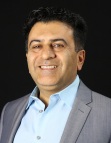 Majid
Bemanian, Director of Segment Marketing for MIPS. Majid
Bemanian, Director of Segment Marketing for MIPS.
“Trust Management from Node to Cloud.“
Abstract: With the dawn of the Internet of Things (IoT) we are seeing a
transition from previously closed platforms to open platforms. This
introduces a number of challenges for manufacturers of products in ensuring
reliable and secure management, monitoring and provisioning of services. The
challenges are even greater for designers of medical devices, where the
issues can be life and death. Manufacturers must build products that support
OTA updates while also ensuring that the device is running the original
manufacturer-installed software (anti-cloned) and that the platform is
operating in the manufacturer’s intended state managed by the original
software (not compromised during operation). It is vital that a chain of
trust be established from silicon through to service provisioning to achieve
mutual trust. Building a chain of trust requires multiple cryptographic
touch points to be available, ensures the integrity and authenticity of the
end devices, and ensures that there are linkages between the various aspects
to stop malware or other subversive actors from compromising the digital
exchange. We will discuss the “trust” stack that is needed to provide this
end-to-end solution, including the APIs needed within embedded devices and
touching on what’s needed in the network and server. We will also discuss a
cross-industry open source effort to define the interface specification of
the Trust Continuum to enable interoperability between the different
components of the embedded device and cloud services.
Bio: Majid Bemanian is
Director of Segment Marketing for MIPS, responsible for driving strategic
security initiatives and leading market strategy for networking and storage.
He also co-chairs the prpl Foundation’s security working group, focused on
developing open standards and APIs around next-generation embedded security
solutions. Mr. Bemanian was previously Director of Segment Marketing for
Imagination Technologies for four years, and prior to that was Director of
Marketing for the Processor Business Unit at AppliedMicro. He has more than
30 years of high-tech industry experience with hands-on engineering,
marketing and business management skills. Bemanian has held key management
positions with Amdahl Communications, Ascom-Timeplex, Encore Video, Raytheon
Semi, LSI Logic, AppliedMicro and many early-stage startups. He holds
several patents and a B.S. degree in Electrical Engineering from the
University of Nevada, Reno.
|
|
|
|
prpl Foundation

|
 Art
Swift, President, prpl Foundation. Art
Swift, President, prpl Foundation.
“RISC-V and prpl: Why RISC-V could become the most secure embedded processor
architecture."
Abstract: In this presentation, Art Swift, president of the prpl foundation,
will describe current challenges in securing the IoT and a security
framework to address these challenges developed by the members of the prpl
Foundation. He will contrast the security offerings of the two leading
embedded processor architectures, Arm and MIPS, and how they stack up
against the framework. Swift will then assess whether the upstart, open
source RISC-V ISA could become the ultimate winner for security in embedded
applications.
Bio: Art Swift is president of
the prpl Foundation. He has more than 20 years of executive-level experience
in the tech industry, including CEO at low power chip-maker Transmeta (Nasdaq,
TMTA), CEO of nanotech innovator Unidym, and vice president of marketing and
business development at MIPS, a leading provider of microprocessor IP.
Earlier in his career, Art was president of ISDCorp, a supplier of Linux
engineering services to Fortune 500 companies; and chief operating officer
for Lynuxworks, provider of the BlueCat Linux distribution and the LynxOS
Linux-compatible real-time operating system. He also served in executive
level positions for Cirrus Logic, a leading System-on-Chip supplier; and Sun
Microsystems; one of the pioneering companies in networked computing and
RISC processing. Art holds a B.S. degree in electrical engineering
from Pennsylvania State University. He is co-inventor of three U.S. patents.
Art continues to serve as CEO of CUPP Computing AS, a European supplier of
mobile security devices. He is also on the board of Numascale AS, a European
supplier of affordable hardware solutions for big data applications, and the
Foothill De Anza Foundation, an education-focused non-profit.
|
|
|
|
Panel







"FREE"
|
Panel:
“Security Issues and Challenges in The Next Generation of SoC Designs for
Emerging Applications. Can You Make Cents of It?"
Moderator: Farhad Mafie, SoC Conference Chairman.
Panelists:
1.
Dr. Pim Tuyls, Founder and Chief Executive
Officer, Intrinsic ID.
2. Marc Canel, Vice President, Security Technologies, ARM.
3. Louis Parks – President and CEO, SecureRF
4. Dr.
Hoon Choi, Design Engineer Senior Director, Lattice Semiconductor.
5. Asaf
Ashkenazi, Vice President, IoT security products, Rambus Security Division.
6. Michael
Y. Chen, Director, Design for Security Business Unit, New Ventures Division,
Mentor, A Siemens Business.
This
Panel Is Open To Everyone . . .
Register Online for FREE Panel Pass
More
Updates Coming Soon . . .
Several
Opportunities to Win various Prizes During this Panel Discussion . . .
Don't
Miss Out! |
|
|
|
Savant Company Inc.

SoC
Conference
|
 Farhad
Mafie, SoC Conference Chairman. Farhad
Mafie, SoC Conference Chairman.
Moderator
Bio: Farhad Mafie is SoC
Conference Chairman. He has over 20 years of experience in semiconductor and
computer businesses and more than 10 years of university-level teaching
experience. He is the former Vice President of Marketing and Engineering at
Toshiba Semiconductor. He has also worked in strategic marketing, project
and design engineering at Lucent Technologies, Unisys, and MSI Data. Farhad
has a Master of Science and a Bachelor of Science degree in Electronic
Engineering from California State University, Fullerton. He is an author and
a translator, and his articles have been published in a variety of journals
and Web-based magazines on technology and political affairs. In 2003, he
published the biography of Iranian poet and Nobel nominee who lived in
exile, Nader Naderpour (1929-2000), Iranian Poet, Thinker, Patriot. Farhad
is also Editor-in-Chief for the CRC Press SoC Design and Technologies Book
Series, which includes (1) Low-Power NoC for High-Performance SoC Design and
(2) Design of Cost-Efficient Interconnect Processing Units. Farhad is an
active member of IEEE, and he is the chair of IEEE Orange County Solid-State
Circuits Society (SSCS), as well as IEEE Orange County Entrepreneurs'
Network (OCEN). He is also a member of two UCI Advisory Committees:
Communication System Engineering and Embedded System Engineering Certificate
Programs.
This Panel Is Open To
Everyone . . .
Register Online for FREE Panel Pass
More
Updates Coming Soon . . .
Several Opportunities to
Win various Prizes During this Panel Discussion . . .
Don't Miss Out!
|
|
|
|
ARM
Panelist

|
 Marc
Canel, VP security systems in ARM’s SW and Systems group. Marc
Canel, VP security systems in ARM’s SW and Systems group.
Panelist
Bio: Marc Canel has extensive
experience in the mobile devices industry, driving software projects for the
past 25 years, focusing on how mobile devices work with the Enterprise
world. He is Vice President of Security Systems at ARM Inc for the past 2.5
years, leading the next generation of security architectures to become the
foundation for Enterprise applications in a connected world. He promoted the
definition of Trust systems and standards for devices in the Internet. He
defined the architecture for the next generation Root of Trust for
applications in devices. Prior to ARM Inc, he was Vice President of Software
& Security Systems at Qualcomm where he spent 18 years, focusing on the
features that make the products of Qualcomm more attractive to Enterprises.
He led Qualcomm to become a leader in the area of content protection and
privacy management. He also worked on the software ecosystem management of
Qualcomm, supporting the OEMs customers looking for complete solutions.
Prior to Qualcomm, he was at IBM for 12 years where he had various roles in
product development and management roles in data networking products.
|
|
|
|
Intrinsic ID
Panelist

|
 Dr.
Pim Tuyls, Founder and Chief Executive Officer, Intrinsic ID. Dr.
Pim Tuyls, Founder and Chief Executive Officer, Intrinsic ID.
Panelist
Bio: Dr. Pim Tuyls
initiated work on Hardware Intrinsic Security™ within Philips Research in
2002. As a principal scientist, he managed the cryptography cluster in
Philips Research in which the initial research was carried out. Later he
transferred this work to Intrinsic-ID and headed the technology development.
Since 2004, Pim is a visiting professor at the COSIC institute of the
Katholieke Universiteit Leuven. His inventions have resulted in numerous
patents. He is widely accepted for his work in the security field and
Hardware Intrinsic Security in particular. Several of Pim’s papers
relating to secure implementations of Physical Unclonable Functions (PUF)
technology have been published at leading security conferences. He
co-authored the book Security with Noisy Data, which was published by
Springer in 2007.
|
|
|
|
SecureRF
Panelist

|
 Louis
Parks – President and CEO, SecureRF. Louis
Parks – President and CEO, SecureRF.
Panelist
Bio: Mr. Parks is
a co-founder of SecureRF, and serves as its President and Chief Executive
Officer. He also serves on the company’s Board of Directors and its
Chairman. Prior to joining SecureRF, Mr. Parks was the Senior Vice President
of Marketing and Strategy for Global Logistics Technology, Inc. (“G-Log”),
an innovative internet logistics company that was acquired by Oracle
Corporation. For 10 years preceding G-Log, he was CEO/President of Client
Technologies, Inc., a New York-based provider of Customer Relationship
Management (CRM) applications for the financial sector that was acquired by
a Canadian company. Mr. Parks also served as President of RKO/Warner Video
where he was responsible for technology, operations and acquisitions
throughout North America. Early in his career, he held both sales and
engineering positions with IBM. Mr. Parks has consulted to Homeland Security
on U.S. electronic border initiatives and has served as a resource to the
White House on security issues related to the new electronic passports and
passport cards. He is on the North American Board of AIM, the Association
for Automatic Identification and Mobility, and is the former chairman of its
RFID Experts Group (REG). He was on the Board of Advisors of the National
Center for Aerospace Leadership (NCAL), a partnership between US industry,
academia and government teams, and is currently an active member on the GS1/EPCglobal
and US TAG ISO standards committees.
Mr. Parks holds a Bachelor of Commerce (with Honors) in Finance and
Marketing from the University of Manitoba.
|
|
|
|
Lattice Semiconductor
Panelist

|
 Dr.
Hoon Choi, Design Engineer Senior Director, Lattice Semiconductor. Dr.
Hoon Choi, Design Engineer Senior Director, Lattice Semiconductor.
Panelist
Bio: Hoon Choi is a
Design Engineer Senior Director at Lattice Semiconductor, where he is
involved in the spec and design of multiple generations of HDMI for the last
13+ years. Choi has led the design of HDCP 2.2 on the HDMI and compliance
test spec. Additionally, he led the spec and implementation of UCP
(China-CP) and the authentication implementation activity for Type-C. Prior
to joining Lattice, Choi got his Ph.D from KAIST in Korea then began his
career in the technology industry by working for Samsung Electronics,
NeoPace Telecom, and Silicon Image which was acquired by Lattice. |
|
|
|
Rambus
Panelist

|
 Asaf
Ashkenazi, Vice President, IoT security products, Rambus Security Division. Asaf
Ashkenazi, Vice President, IoT security products, Rambus Security Division.
Panelist
Bio: Asaf Ashkenazi is a vice
president for IoT security products at Rambus Security division. In this
role, Asaf is responsible for the product definition, strategy and marketing
of Rambus IoT security products. Asaf brings more than 15 years of security
experience to the organization, spanning product management, business
development and various engineering roles throughout his career. Prior to
joining Rambus, Asaf oversaw product management for all of the security
products at Qualcomm Technologies Inc. Asaf began his career at Motorola
Semiconductor where he developed hardware security modules. Previously, Asaf
served as Chief Security Architect at Freescale Semiconductor (now NXP), and
has served as board member of the FIDO alliance. Asaf holds a Bachelor of
Science in Electrical Engineering from Ben-Gurion University of the Negev,
Israel, and has been granted 10 U.S. patents for security architectures and
solutions.
|
|
|
|
Mentor, A Siemens Business
Panelist

|
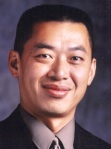 Michael
Y. Chen, Director, Design for Security Business Unit, New Ventures Division,
Mentor, A Siemens Business. Michael
Y. Chen, Director, Design for Security Business Unit, New Ventures Division,
Mentor, A Siemens Business.
Panelist
Bio: Michael Chen
is currently a Business Unit Director in the New Ventures Division at Mentor
Graphics. As such, Michael manages leading-edge technology efforts for the
company’s Design for Security initiative. Michael’s other positions during
his more than 20 years at Mentor include serving as an account manager,
field marketing manager for Asia Pacific, product line director for various
products, and business unit director for SoC verifications products, with
responsibility for HW/SW integration and electronic system-level design and
verification solutions. Prior to joining Mentor, Michael was a senior
consultant and field application engineer at Hewlett Packard and a logic
simulator programmer for Xerox. He is a licensed Professional Engineer and
holds several patents. He currently serves as Chair of the T3S TAB committee
with the Semiconductor Research Corporation (SRC). Michael holds a B.S.E.E.
and a B.S. in Information and Computer Science from the University of
California, Irvine, graduating with honors. He is fluent in both Mandarin
Chinese and Japanese and is well versed in both of those cultures.
|
|
|
|
|
Open To Everyone
Reception & Networking
|
|
|
|
|
15th International SoC
Conference Closed.
|
|
|
|
|
|
|
|
|
* * * * * * *
* SoC Conference Program is subject to change.
Savant Company Inc, SoC Conference Organizing Committee, and Technical Advisory
Board, reserve the rights to revise or modify the SoC Conference
agenda at
its sole discretion.
Back To The Main SoC
Conference Page
|
|
Copyright © 2003-2018 by Savant Company Inc. All
Worldwide Rights Reserved. | |
|